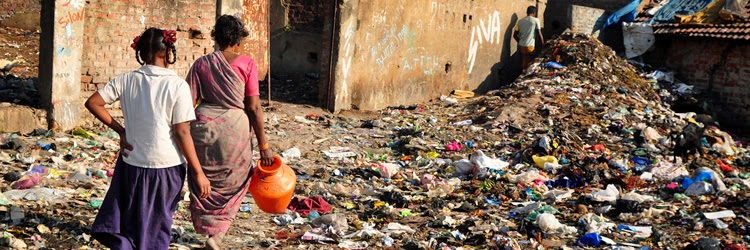Poverty. For a long while now, this word
has been synonymous with India on a global scale. As outrageous as it sounds,
the fact remains that one third of the World's Poor are from our country.
Many people fail to comprehend the gravity
of the situation. Though poverty as a percentage of the whole has been reduced,
in terms of absolute numbers, it is growing at an alarming rate. The scale of
continuing extreme poverty in India, despite its economy nudging growth rates
of nine per cent in recent years, highlights what government strategists have
called its "ticking time bomb". Its population is expected to reach
1.5 billion and become the world's largest nation by 2026 but its economy is not
growing fast enough to create the 20 million new jobs per year we will need to
prevent poverty increasing further.
There is no
single cause for this social evil, instead a multitude of reasons which
complement each other strengthen poverty. One of the major leading causes
stated is Overpopulation. It is also stated that overpopulation is a result of
poverty. Its problems are compounded by poor health services, child
malnutrition and inadequate education and training. Almost half of pupils drop
out of school by the age of 13 and only one in ten people have received any
form of job training. India's status has gone down despite the economic growth,
inequality has widened which makes the poor poorer. In child mortality, infant
mortality and maternal mortality, India seems to have the largest populations
in all these categories. Another reason factoring in for the growth of poverty
in the 1980s-2000s is the economic policies of India. India had started out in
the 1950s with high growth rates, openness to trade and investment, a
promotional state, social expenditure awareness and macro stability but ended
the 1980s with low growth rates, closure to trade and investment, a
license-obsessed restrictive state (License Raj), inability to sustain social
expenditures and macro instability, indeed economic crisis.
Efforts to alleviate poverty have not been
successful because the rate of poverty reduction lags behind the rapid
population growth rate. Eradication of poverty is right now considered only to
be a long term goal. But an indirect result can be achieved by curbing the
rates of malnutrition among children as well as child mortality, infant
mortality and maternal mortality. Better healthcare facilities and provision of
food form the backbone for the solution to poverty. Another major factor is
education. Educating children and improving the literacy rate in our country
can catalyse poverty alleviation. Increasing stress on education, reservation
of seats in government jobs and the increasing empowerment of women and the
economically weaker sections of society are also expected to contribute to the
alleviation of poverty.
Fundamentally, poverty is the inability of
getting choices and opportunities, a violation of human dignity. It means lack
of basic capacity to participate effectively in society.Fundamentally, poverty is the inability of
getting choices and opportunities, a violation of human dignity. It means lack
of basic capacity to participate effectively in society. Unless poverty has
been tackled effectively, no real progress in development can be achieved. But
now, we are better equipped to deal with poverty. Poverty alleviation is
expected to make better progress in the next 50 years than in the past, as a
trickle-down effect of the growing middle class. Reduction in poverty levels
has a long way to go yet and in this battle Education is our weapon.





